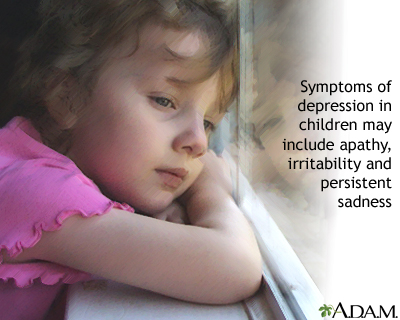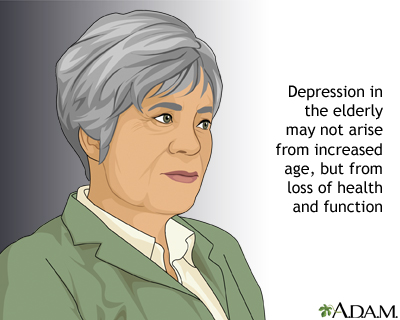Suicide and suicidal behavior
Depression - suicide; Bipolar -suicide
Suicide is the act of taking one's own life on purpose. Suicidal behavior is any action that could cause a person to die, such as taking a drug overdose or crashing a car on purpose.
Images


Causes
Suicide and suicidal behaviors usually occur in people with one or more of the following:
- Bipolar disorder
- Borderline personality disorder
- Depression
- Drug or alcohol use
- Post-traumatic stress disorder (PTSD)
- Schizophrenia
- History of physical, sexual, or emotional abuse
- Stressful life issues, such as serious financial or relationship problems
- Diagnosis of a terminal illness
People who try to take their own life are often trying to get away from a situation that seems impossible to deal with. Many who attempt suicide are seeking relief from:
- Feeling ashamed, guilty, or like a burden to others
- Feeling like a victim
- Feelings of rejection, loss, or loneliness
Suicidal behaviors may occur when there is a situation or event that the person finds overwhelming, such as:
- Aging (older people have the highest rate of suicide)
- Death of a loved one
- Drug or alcohol use
- Emotional trauma
- Serious physical illness or pain
- Unemployment or money problems
Risk factors for suicide in teenagers include:
- Access to guns
- Family member who completed suicide
- History of hurting themselves on purpose
- History of being neglected or abused
- Living in communities where there have been recent outbreaks of suicide in young people
- Romantic breakup
While men are more likely than women to die by suicide, women are twice as likely to attempt suicide.
Most suicide attempts do not result in death. Many of these attempts are done in a way that makes rescue possible. These attempts are often a cry for help.
Some people attempt suicide in a way that is less likely to be fatal, such as poisoning or overdose. Men are more likely to choose violent methods, such as shooting themselves. As a result, suicide attempts by men are more likely to result in death.
Relatives of people who attempt or complete suicide often blame themselves or become very angry. They may see the suicide attempt as selfish. However, people who attempt suicide often mistakenly believe that they are doing their friends and relatives a favor by taking themselves out of the world.
Symptoms
Often, but not always, a person may show certain signs and behaviors before a suicide attempt, such as:
- Having trouble concentrating or thinking clearly
- Giving away belongings
- Talking about going away or the need to "get my affairs in order"
- Suddenly changing behavior, especially calmness after a period of anxiety
- Losing interest in activities they used to enjoy
- Self-destructive behaviors, such as heavily drinking alcohol, using illegal drugs, or cutting their body
- Pulling away from friends or not wanting to go out
- Suddenly having trouble in school or work
- Talking about death or suicide, or even saying that they want to hurt themselves
- Talking about feeling hopeless or guilty
- Changing sleep or eating habits
- Arranging ways to take their own life (such as buying a gun or many pills)
Treatment
People who are at risk of suicidal behavior may not seek treatment for many reasons, including:
- They believe nothing will help.
- They do not want to tell anyone they have problems.
- They think asking for help is a sign of weakness.
- They do not know where to go for help.
- They believe their loved ones would be better off without them.
A person may need emergency treatment after a suicide attempt. They may need first aid, CPR, or more intensive treatments.
People who try to take their own life may need to stay in a hospital for treatment and to reduce the risk of future attempts. Therapy is one of the most important parts of treatment.
Any mental health disorder that may have led to the suicide attempt should be evaluated and treated. This includes:
- Bipolar disorder
- Borderline personality disorder
- Drug or alcohol dependence
- Major depression
- Schizophrenia
- Post-traumatic stress disorder (PTSD)
Always take suicide attempts and threats seriously. If you or someone you know is thinking about suicide, call or text 988 or chat 988lifeline.org. You can also call 1-800-273-8255 (1-800-273-TALK). The 988 Suicide and Crisis Lifeline provides free and confidential support 24/7, anytime day or night.
You can also call 911 or the local emergency number or go to the hospital emergency room. DO NOT delay.
Call 911 or the local emergency number right away if someone you know has attempted suicide. DO NOT leave the person alone, even after you have called for help.
Support Groups
More information and support for people in crisis and their loved ones can be found at the:
988 Suicide and Crisis Lifeline:
- Help and support for people in crisis: 988lifeline.org/talk-to-someone-now
- Help and support for loss survivors: 988lifeline.org/help-yourself/loss-survivors/
Veteran's Crisis Line: www.veteranscrisisline.net/
American Foundation for Suicide Prevention: afsp.org/get-help
Outlook (Prognosis)
About 10% to 20% of people who make threats or try to take their own life will eventually kill themselves.
When to Contact a Medical Professional
Contact a health care provider right away if you or someone you know is having thoughts of suicide. The person needs mental health care right away. DO NOT dismiss the person as just trying to get attention.
Prevention
Avoiding alcohol and drugs (other than prescribed medicines) can reduce the risk of suicide.
In homes with children or teenagers:
- Keep all prescription medicines high up and locked.
- Do not keep alcohol in the home, or keep it locked up.
- Do not keep guns in the home. If you do keep guns in the home, lock them and keep the bullets separate.
In older adults, further investigate feelings of hopelessness, being a burden, and not belonging.
Many people who try to take their own life talk about it before making the attempt. Sometimes, just talking to someone who cares and who does not judge them is enough to reduce the risk of suicide.
However, if you are a friend, family member, or you know someone who you think may attempt suicide, never try to manage the problem on your own. Seek help. Suicide prevention centers have telephone "hotline" services.
Never ignore a suicide threat or attempted suicide.
References
American Psychiatric Association. Other conditions that may be a focus of clinical attention. Diagnostic and Statistical Manual of Mental Disorders. 5th ed. Text Revision (DSM-5-TR). Arlington, VA: American Psychiatric Publishing; 2022:chap 22.
Brendel RW, Koh KA, Perlis RH, Stern TA. Care of the suicidal patient. In: Stern TA, Freudenreich O, Smith FA, Fricchione GL, Rosenbaum JF, eds. Massachusetts General Hospital Handbook of General Hospital Psychiatry. 7th ed. Philadelphia, PA: Elsevier; 2018:chap 44.
DeMaso DR, Walter HJ. Suicide and attempted suicide. In: Kliegman RM, St. Geme JW, Blum, NJ, Shah SS, Tasker RC, Wilson KM, eds. Nelson Textbook of Pediatrics. 21st ed. Philadelphia, PA: Elsevier; 2020:chap 40.
BACK TO TOPReview Date: 5/10/2023
Reviewed By: Fred K. Berger, MD, addiction and forensic psychiatrist, Scripps Memorial Hospital, La Jolla, CA. Also reviewed by David C. Dugdale, MD, Medical Director, Brenda Conaway, Editorial Director, and the A.D.A.M. Editorial team.

Health Content Provider
06/01/2025
|
A.D.A.M., Inc. is accredited by URAC, for Health Content Provider (www.urac.org). URAC's accreditation program is an independent audit to verify that A.D.A.M. follows rigorous standards of quality and accountability. A.D.A.M. is among the first to achieve this important distinction for online health information and services. Learn more about A.D.A.M.'s editorial policy, editorial process and privacy policy. A.D.A.M. is also a founding member of Hi-Ethics. This site complied with the HONcode standard for trustworthy health information from 1995 to 2022, after which HON (Health On the Net, a not-for-profit organization that promoted transparent and reliable health information online) was discontinued. |
The information provided herein should not be used during any medical emergency or for the diagnosis or treatment of any medical condition. A licensed medical professional should be consulted for diagnosis and treatment of any and all medical conditions. Links to other sites are provided for information only -- they do not constitute endorsements of those other sites. © 1997- 2025 A.D.A.M., a business unit of Ebix, Inc. Any duplication or distribution of the information contained herein is strictly prohibited.
